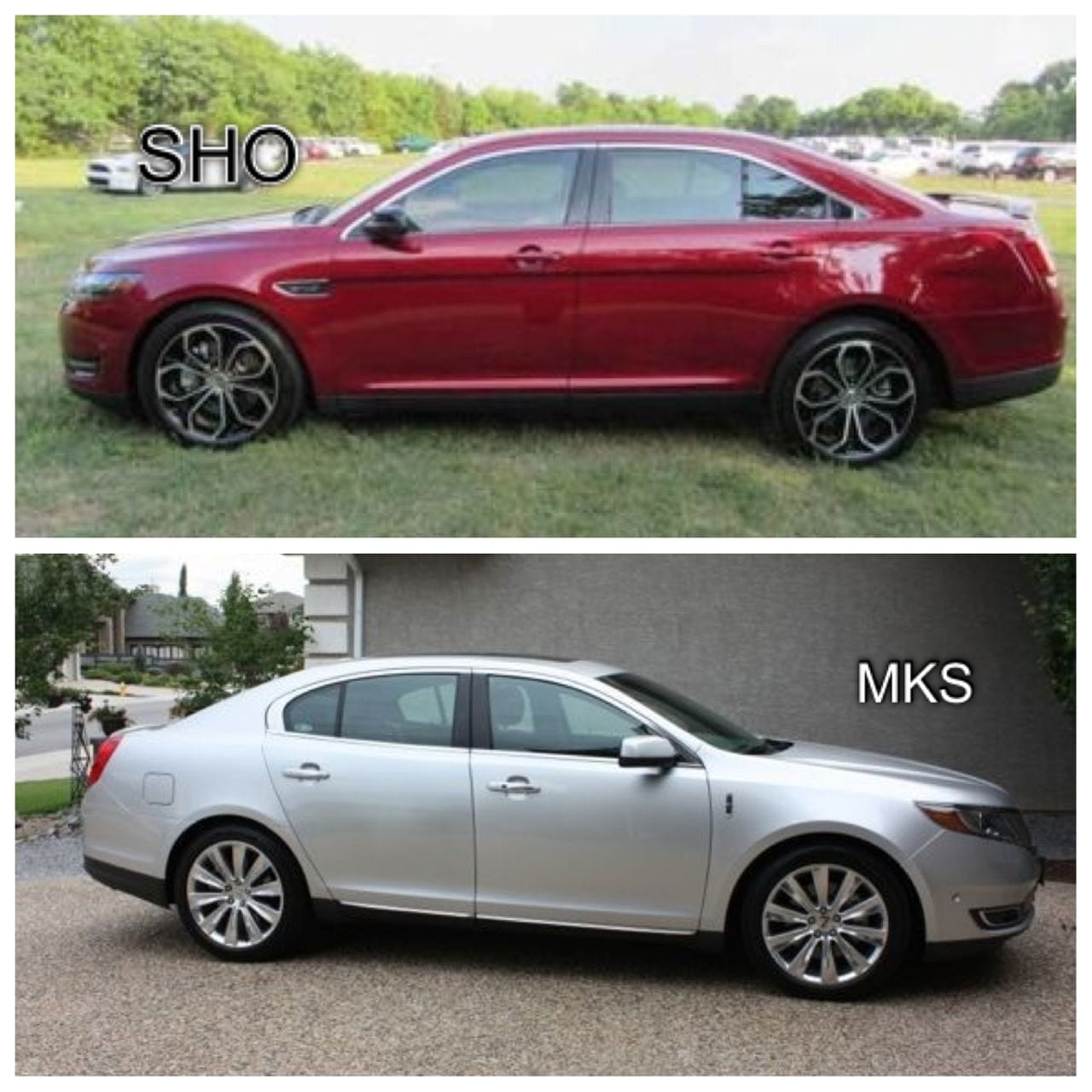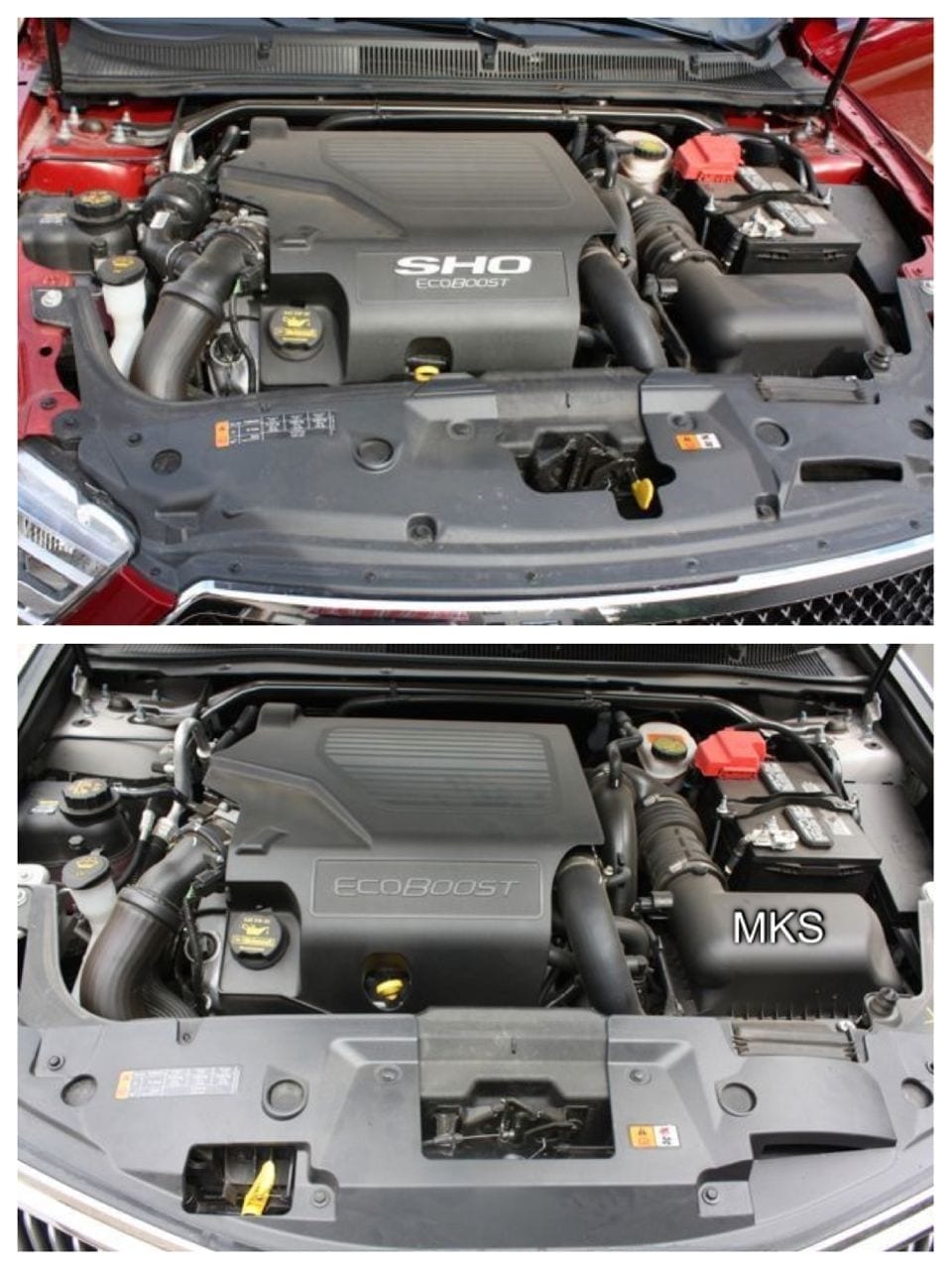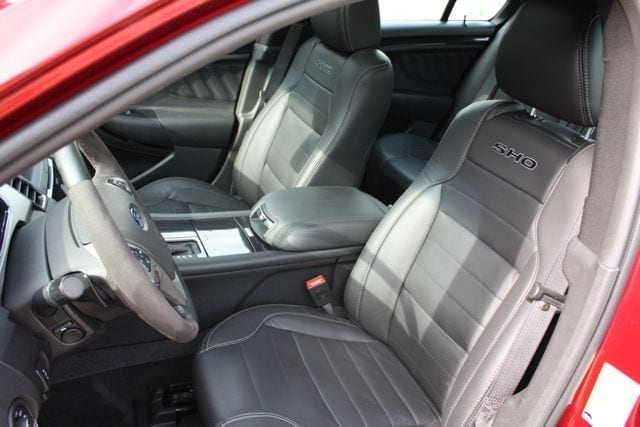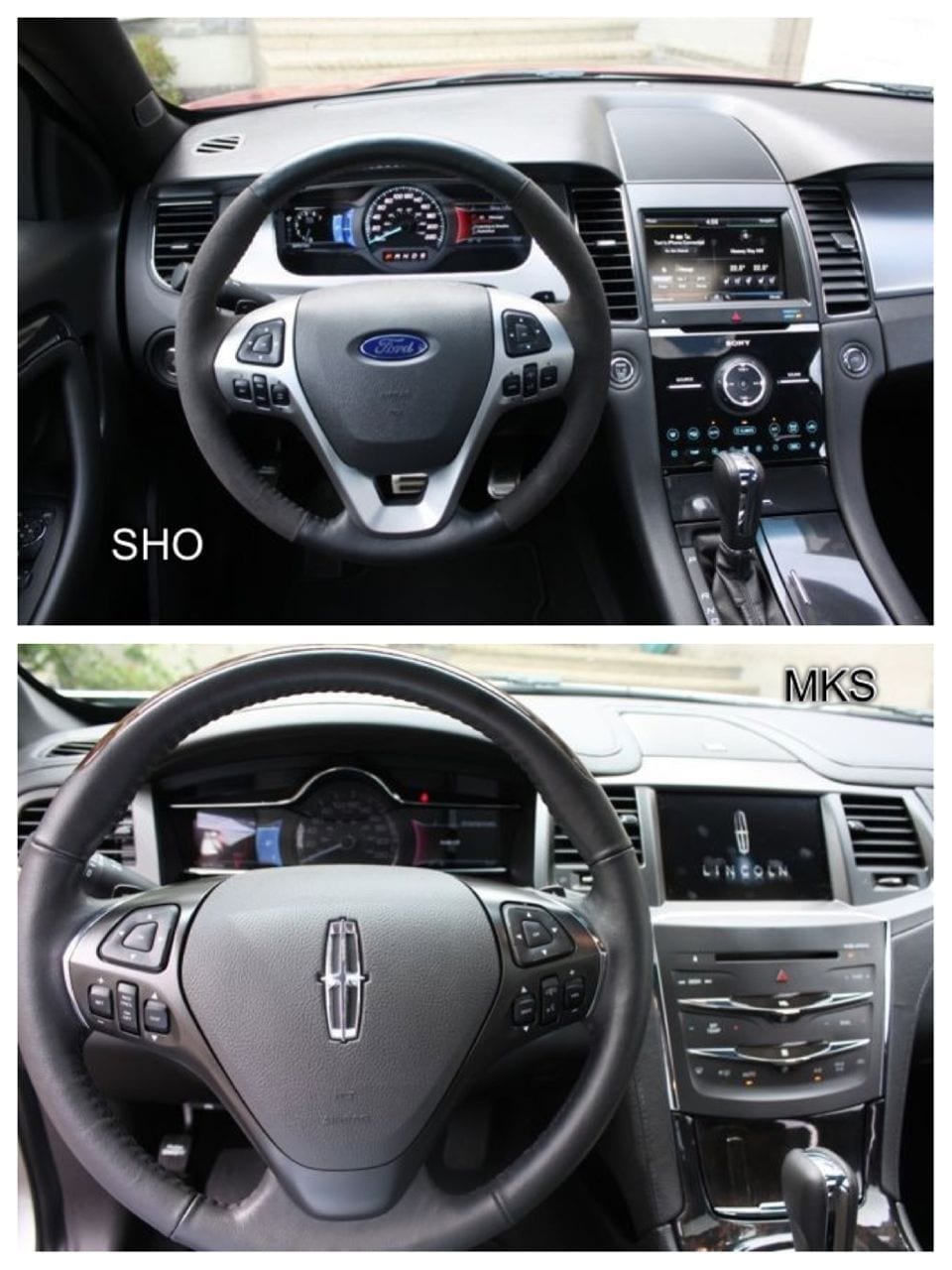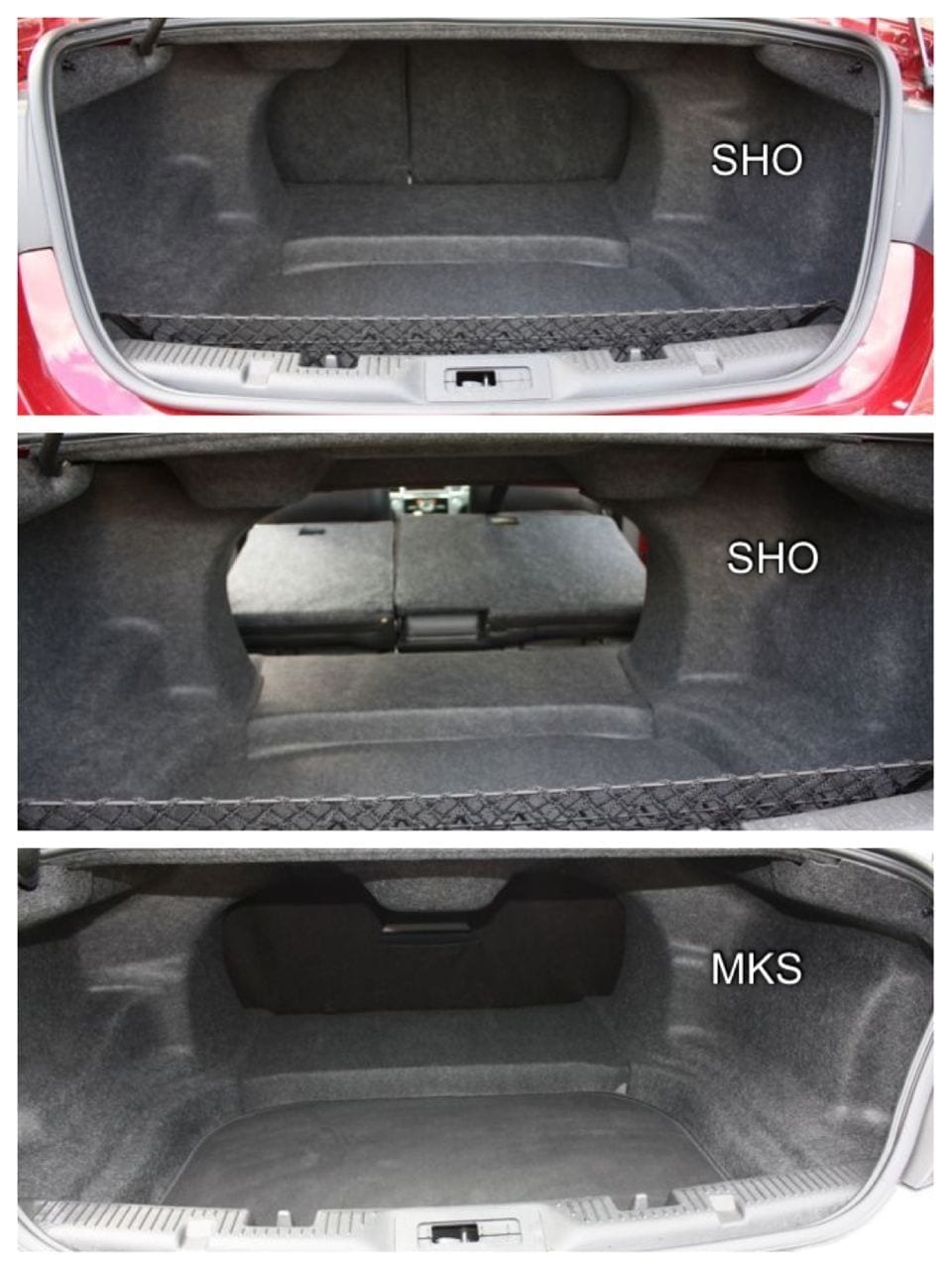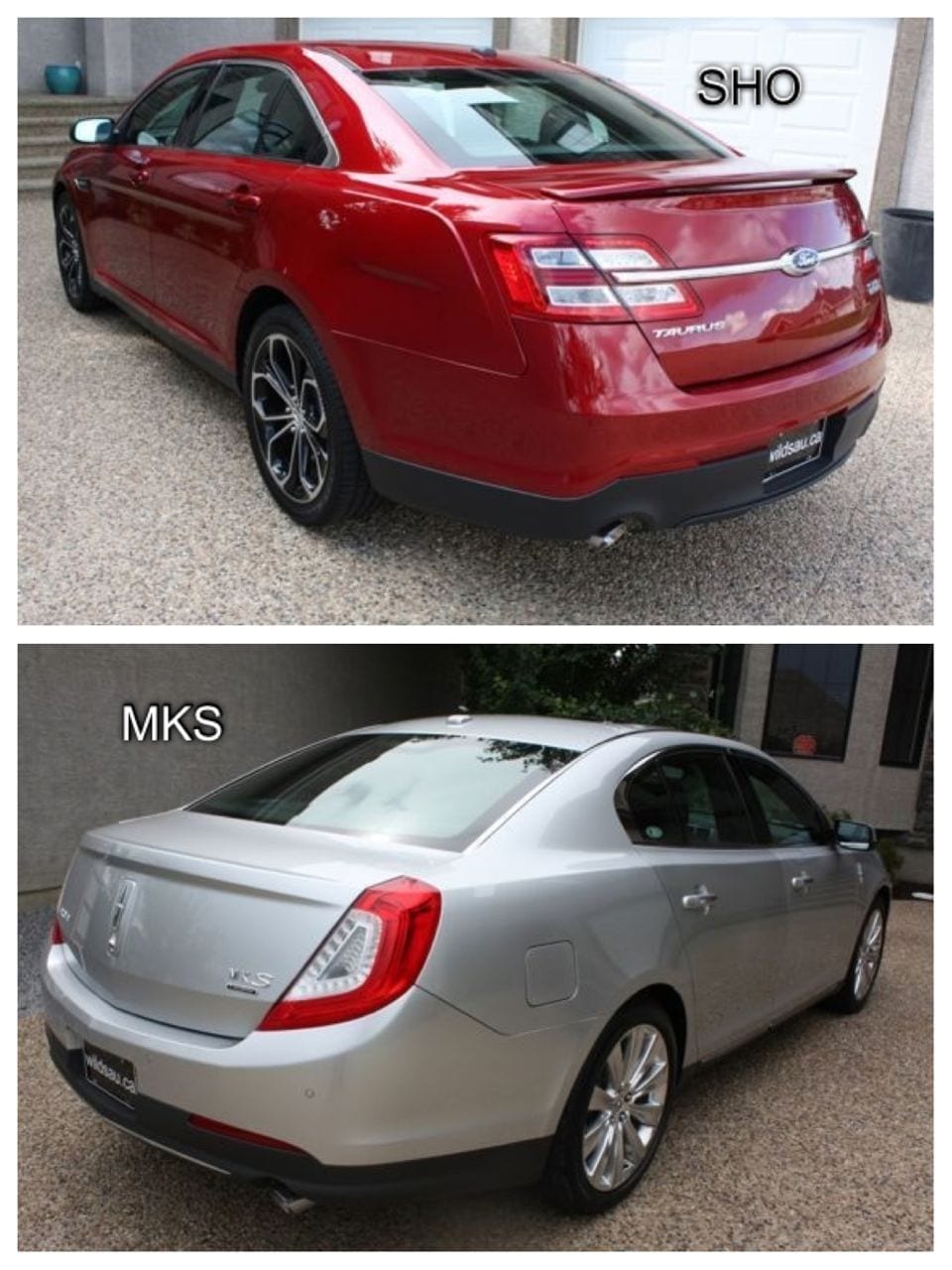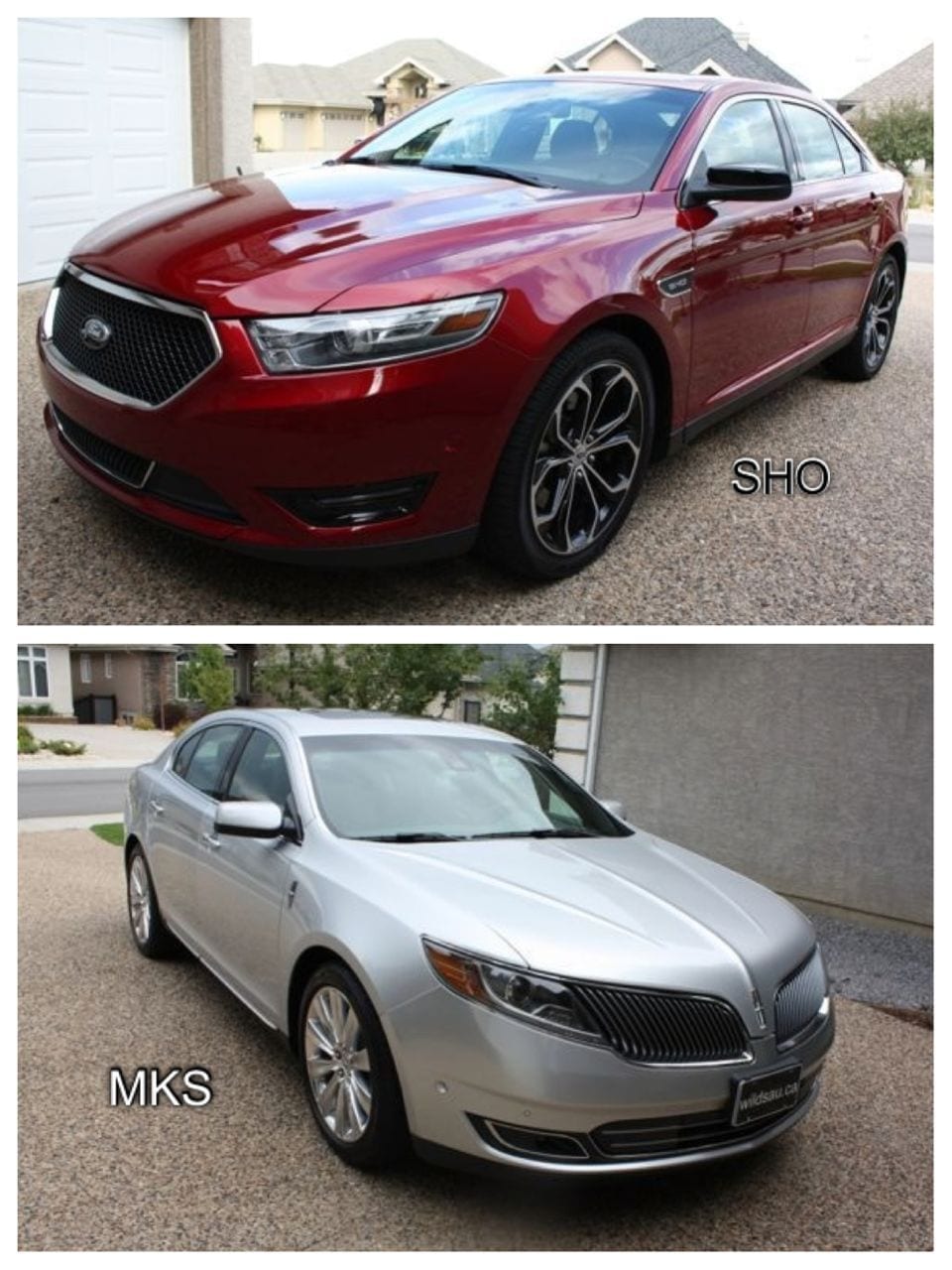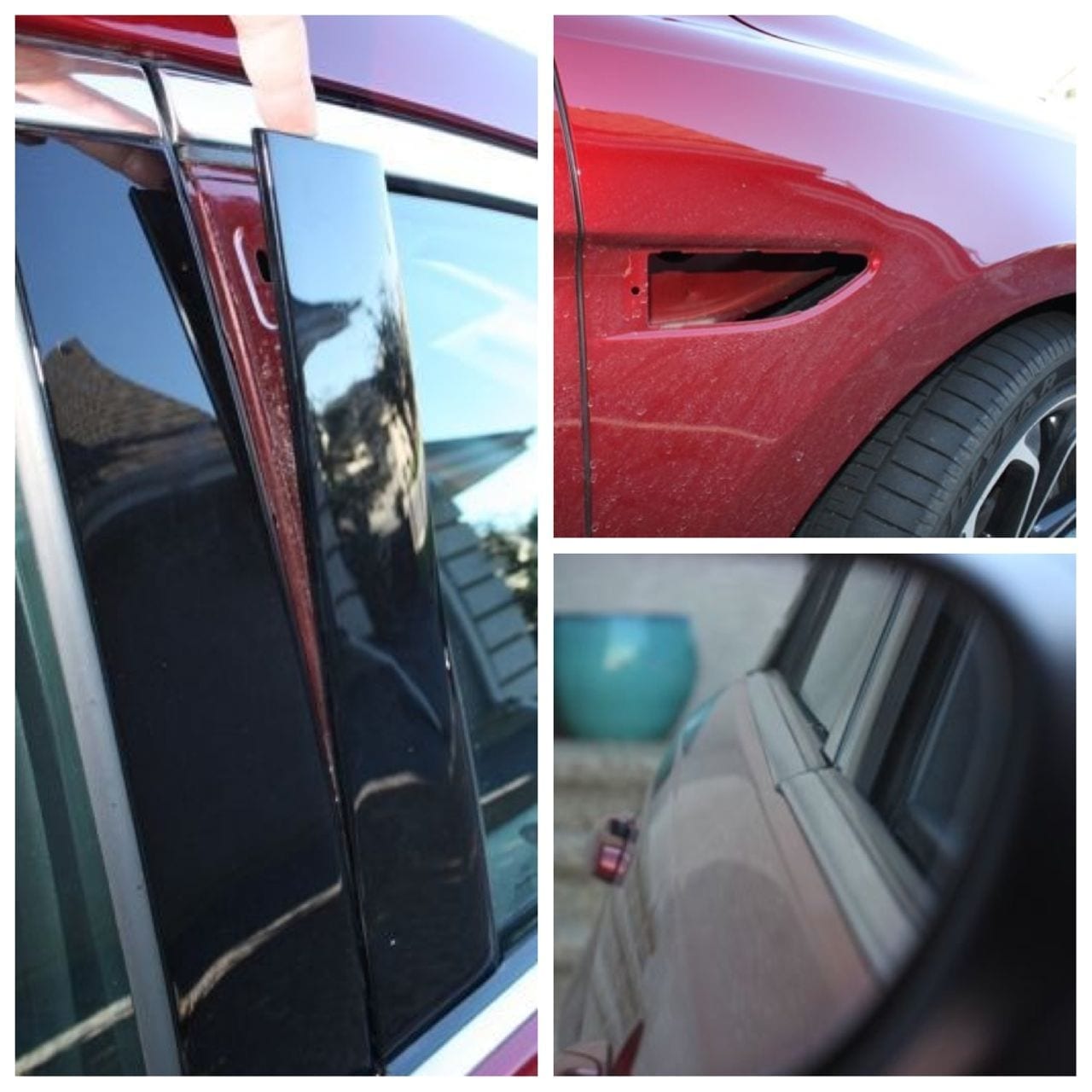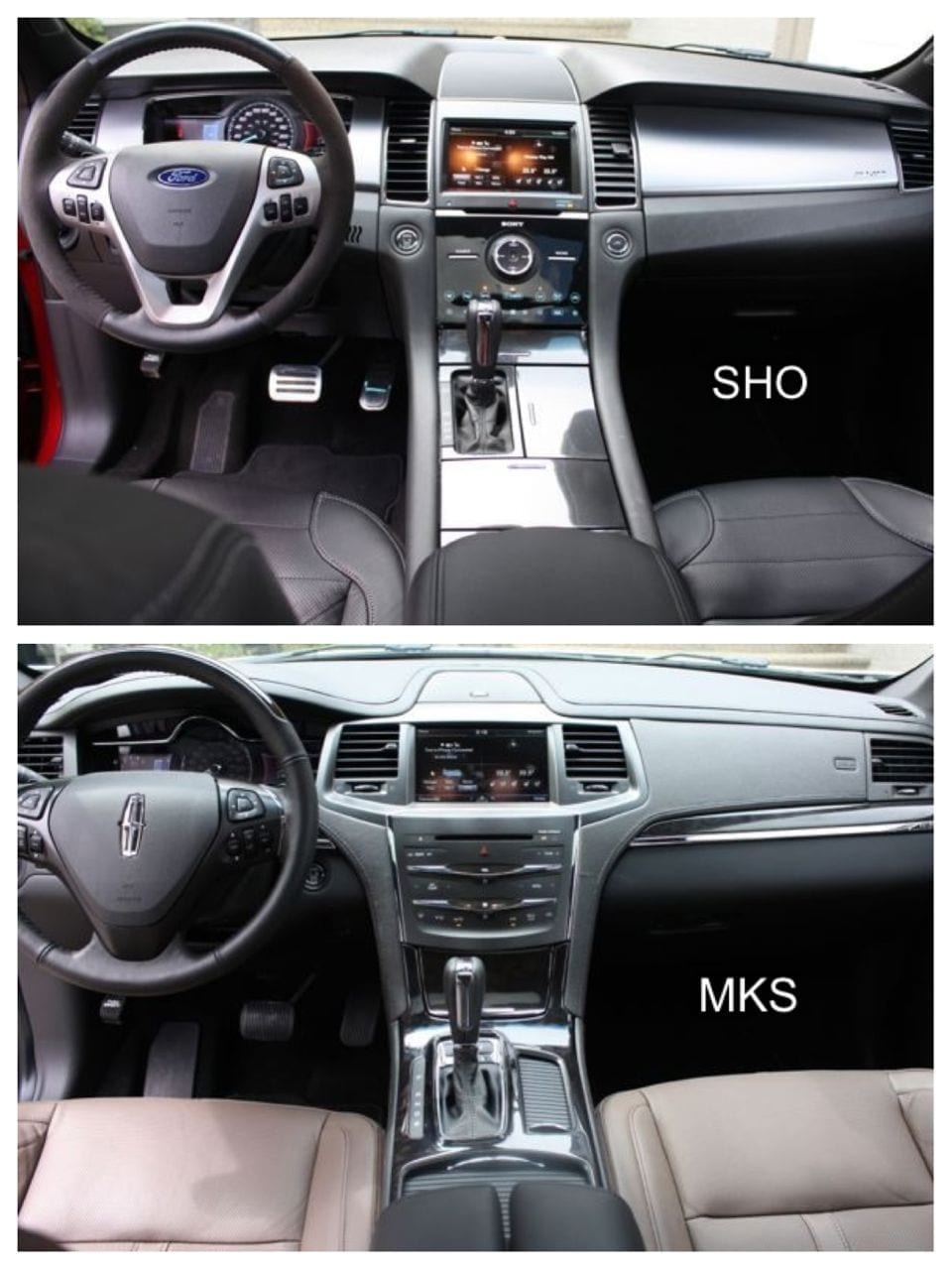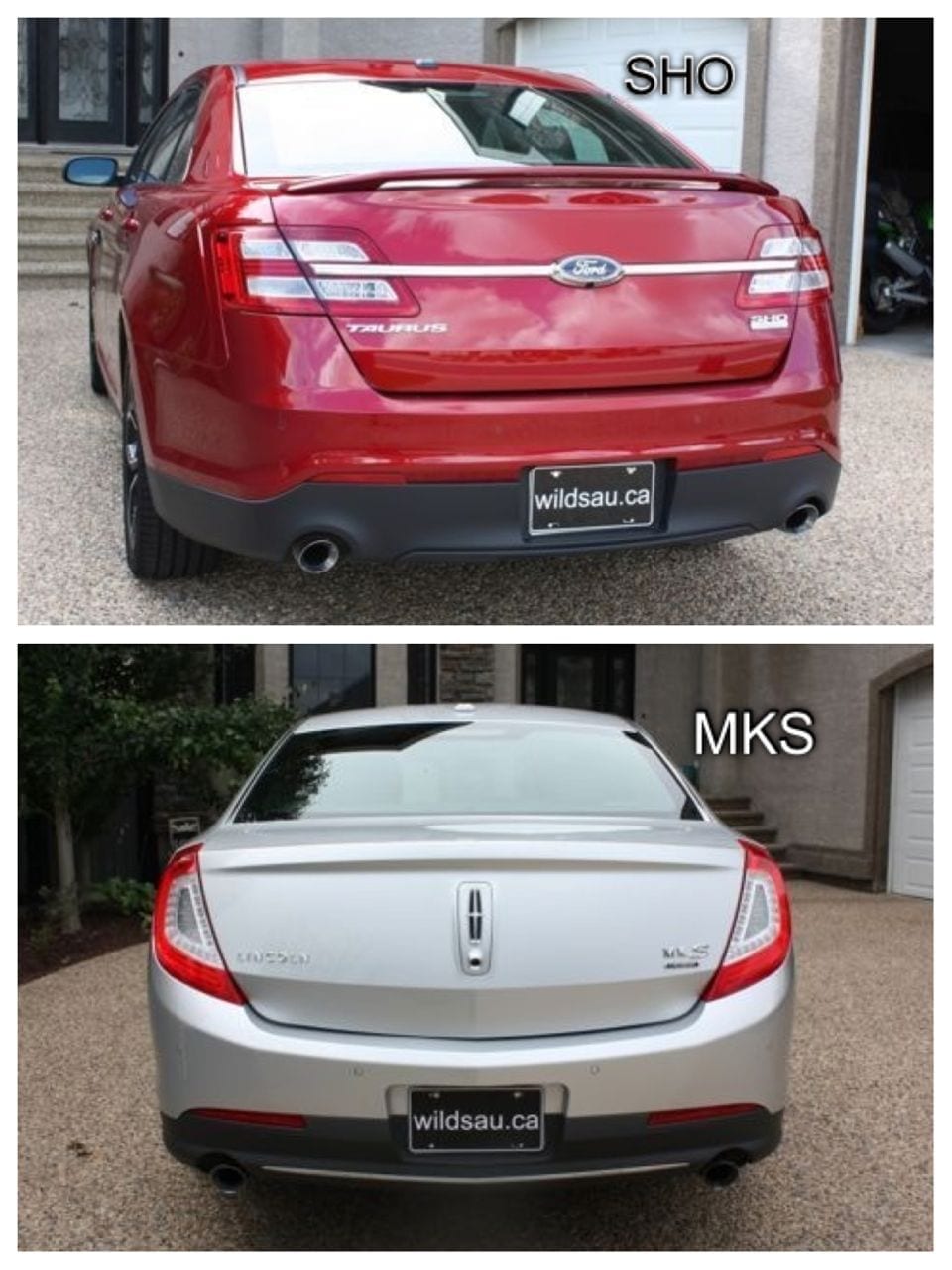I spent a week with each of these cousins. Though they’re virtually the same, mechanically and dimensionally speaking, they do differ in many ways.
The Taurus SHO is marketed as a hot-rod, and this one even came with a Performance Package which Ford touts as making this car track-ready. The MKS is more understated and sauve and goes about its business quietly.
The Taurus SHO starts at CDN $41,287, and the one I had with the Performance Package and some other goodies came in at CDN $53,599. Lincoln’s MKS starts at $44,184 – add the EcoBoost engine and some treats, like the one I had, and you’ll be paying CDN $63,600. Ouch.
Exterior/Under the Hood
The SHO is all brute. The new Taurus is a big car. I mean, it’s huge. It’s got big rear haunches, it’s tall, and it’s wide. The SHO makes no effort to hide this. The grille is blacked out with mesh. There are big faux air vents on the cowl that shout “SHO!” and there’s a trunk spoiler that will keep this thing on the road during high-speed maneuvering. Haha, OK, OK, it’s for looks. The Performance package adds some spicy-looking 20″ rims with saucy summer rubber. Pictures don’t do these rims justice. The cues are all muscle-car, and I thought the SHO looks good. But it can’t fool anyone into thinking it’s anything but a big, heavy sedan that’s got some balls. Which is exactly what it is. The SHO gets a lot of looks on the road.
On the other hand, the MKS comes to the party in a tux. It has very, very similar lines, but somehow they come across as slicker and more confident. I love the maturity of the MKS. Much less muscle-car in appearance, the only hints at what it might be able to do are the discrete EcoBoost badging and the massive, and gorgeous, 20″ rims. I really like the sculpted hood that becomes one with the Lincoln grille.
Both the MKS and the SHO share a set of hefty shoulders under the C-pillar behind the rear doors – those shoulders become the plane of the trunk lid and it’s quite a visual signature. Part of that signature is a very steeply raked back window.
Mechanically, both cars are very close. They are both all-wheel drive sedans with the wonderful EcoBoost engine. It’s a twin-turbocharged V-6 rated at 365 HP at 5500 RPM, and 350 lb.ft at a wickedly low 1500 RPM. There are slight nuances that set them apart. Suspensions differ, and the SHO has upgraded brakes and a different drive ratio, allowing it to get up and go a little quicker. It results in an almost ludicrous 5.2 second run from 0-60 mph. The Lincoln is only a step behind, taking 5.4 seconds to get to 60 mph – a barely-measurable difference. Those are great numbers, especially considering these portly cousins weigh over 4,300 pounds.
The EcoBoost is rated at 13.8 L/100 km (17 mpg) in the city and 9.4 L/100 km (25 mpg) on the highway. In the SHO, I spent a lot of time on the highway, loaded up with my family of 5 and our not-insignificant amount of luggage (I’ll get into that later), traveling at 140 km/h on the average, as well as some aggressive city driving, and I averaged 11.9 L.100 km (19.8 mpg). The MKS was virtually all city driving, much of it aggressive to get into that juicy torque, and I ended up with an average of 15.9 L/100 km (14.8 mpg). Not great, to be sure, but not terrible nor surprising considering how I’m driving. Both sport a 72 Liter fuel tank.
Advantage: MKS – the flexed bicep bully look of the SHO is fun, but I’d rather live with the more understated confidence of the MKS. What’s going on under the hood, even with the slight differences, is too similar for me to say one was better than the other. The advantages and disadvantages of one wash out against those of the other.
Interior/Tech/Convenience
The SHO’s interior is a nicely upgraded version of the Taurus interior. SHO-specific seats, which are very comfortable and look great, show up here, and there is some “woven aluminum” trim on the dash. As sporty as the seats look, they suffer from a complete lack of bolstering – the lateral support is pathetic and they’ll do you no good when you take it to the track, as Ford says you should. Let’s be honest – you won’t be on the track, but they’re just as disappointing on the road when you throw it around a corner heading to soccer practice. The dual hooded dash design worked well for me, and I found everything easy to see, reach, and use. Materials are very nice, with a lot of soft-touch plastic where your hands might fall. The center stack starts with the ubiquitous MyFordTouch screen on top. It handles the media, climate control, navigation and phone functions. The stereo is a Sony-branded one, and sounds great. Below it is the rotary control knob along with some hard buttons. At the front of the console sits a wide pop-up lid, under which you’ll find buttons for Active Park Assist, traction control defeat and the powered rear sunshade as well as a 12V plug. Behind that sits the shift lever and a nice armrest.
The SHO’s Performance package adds Alcantara trim to the steering wheel. That would normally be great, but it remains a thin-rimmed, large diameter steering wheel. Great for road trips. Not great for performance driving. I’d rather see a different steering wheel than a little non-slip Alcantara trim. Oh, you also get very sporty aluminum pedals that will make no difference whatsoever.
Both cars share the same instrument bin – a large centrally-mounted speedometer, flanked by Ford’s wonderful driver information screens. The left offers vehicle settings, digital tach, fuel gauge, fuel consumption and other driving related information. The right allows you to dig into phone, navigation and media information. Both are controlled by D-pads on the steering wheel, and are highly useful and effective. You’ll find all the basics here – powered windows, door locks, mirrors. Steering wheels and pedals are power-adjustable. Front seats are heated and cooled and have driver’s side memory.
The Lincoln adds the best techno-bit yet – massaging seats. These are no joke. You can have your spine or your butt massaged – the butt massage alternates cheeks, y’all. I seriously considered spending a few nights out in the MKS. It sounds hokey, but it is a fantastic addition, and makes a big difference in driver and passenger fatigue during road trips. Anyone who tried it, including my mother-in-law, loved this function. Oh, the MKS also has a 3-level lumbar adjustment – you can move your lumbar support in and out for your upper, middle and lower lumbar area.
You’ll find dash-mounted power trunk release buttons, sunroofs and powered rear-window sunshades, HomeLink garage door openers, a blind-spot monitoring system, Ford’s awesome Active Park Assist for automatic parallel parking, and a back-up camera with distance markings, audible distance sensor warnings AND the highly useful trajectory lines for backing up. Both have the keyless entry and push-start ignitions.
The MKS’ materials are simply lovely. Beautiful soft-touch plastics everywhere, and an interesting combination of black cabin materials, grey-ish brown black wood trim and dark tan seats. It works well. The leather seats are very comfortable and lovely to look at, and although they look well-bolstered, they’re no more performance-oriented than the SHO seats. That’s less of a ding against the MKS than the SHO. The excellent steering wheel has some wood trim on it, there is nice use of stitching on the dash and the fit and finish seemed flawless.
The center stack has the MyLincolnTouch screen at the top, and below it are Lincoln’s strange touch/swipe controls for volume and fan speed, as well as other soft-touch buttons. I’ve went on at length about how much I dislike these swipe controls – I don’t find them intuitive and they don’t work for me. But if you want some positive perspective, they look very clean and lovely since there are no protruding buttons on that entire surface, and luckily the functions are replicated with steering wheel and touch-screen controls.
The console houses the shift lever and an armrest. The top of the lid is split, allowing you to adjust the armrest separately for driver and passenger.
Much like the MKT I reviewed, the MKS is chock-full of techno-goodies. Along with everything you’ll find in the SHO, you also get a lane-departure warning system, adaptive cruise control allowing you to adjust the gap between you and the car ahead of you, and a THX sound system that is stunning. The MKS adds a second sunroof, and both are covered by powered retractable sunshades.
Advantage: MKS – it’s just prettier, more comfortable and more refined
Rear Seats
Space in both cars is basically the same. Headroom is good, but not fantastic – it was just fine for me, but over-six-footers might feel snug. Legroom and footroom is very good.
The rear seats in both vehicles are similar. Three seats, three seatbelts – three headrests in the SHO, two headrests in the MKS. The two outboard seats are heated and very comfortable, and lack any bolstering. I did find the seats in the SHO firmer than I expected, but they’re still comfortable. The middle seat is narrow, raised and suitable only for children or small dogs. The middle seatback folds down in both, creating a decent armrest with two cupholders. The MKS adds a storage bin to that armrest. I should add that, if you have to use the middle seat, both of these rides sport a big raised tunnel in the middle and you’ll likely request to be seated on the roof rack before long.
There are 2 sets of LATCH anchors, and they are strangely moved toward the center of the car. So, if you’re putting two kids’ seats in, there’s no way you’ll be able to use the middle seat for another child. I’m not sure why they wouldn’t leave them closer to the outside like most cars, which allows you to maximize the utility of the rear seat for other passengers/stuff.
Both the SHO and the MKS have air vents and a 12V plug on the back of the center console and 2 seatback map pockets. Interestingly, you won’t find any rear door bins in the MKS.
Advantage: MKS – there isn’t a big difference, but it’s more comfortable and nicer
Storage
The SHO has a decent glove compartment. To the right of the shift lever is a small covered bin with a cupholder and a vertical slot – great for holding a smart phone. There are two cupholders in the console – they’re too close together and our two normal-sized take-out cups’ lids always overlapped. That might sound like a trivial first-world nitpick, but it’s epically irritating when you just want to reach down without looking and grab your cup. Dumb. The armrest lid swings up to reveal a mid-sized carpeted bin with USB, RCA and 12V plugs, as well as a little organizer tray at the top. The door bins are OK and include bottle holders.
The MKS has a bin with a flip-up lid at the bottom of the center stack. To the right of the shift lever is a small bin with a 12V plug – it can be hidden by sliding, retractable lid. Behind it sits the same kind of lid covering two cupholders. The armrest lid flips up to reveal a small-ish carpeted bin with 2 USB plugs, RCA plugs and a 12V plug. Door bins aren’t great – they’re under the door’s armrest. There are small bins on either side of the center console where your knees are – not sure what you’d put there. The glove compartment is a nice, usable size.
The trunk in these cars is simply enormous. Cargo capacity is over 20 cubic feet. I live with a woman who likes her creature comforts – as a reference point, she takes her hot rollers with when we go camping. I also have two daughters that …. um … are following in their mother’s footsteps when it comes to packing. So when we go to our cabin, which we did with the SHO, we need a lot of cargo space. The trunk swallowed everything we threw at it, including all their crap, a huge cooler and an industrial-sized fan AND we had room left over. Very impressive. Need more space? Fold the seats down. Ah, but only in the SHO. Interestingly, the MKS rear seats do not fold down.
One thing I loved about the trunks was the lack of internal hinges. See that? No hinge to swing down and either take up space in a big shrouded compartment, or come down and pinch whatever you’ve put underneath it. The hinges sit on the upper surface, minding their own business outside of the trunk compartment and that’s awesome.
Advantage: SHO – the rear seats fold down which makes a big difference for those times you need the space – otherwise the cars are very similar in terms of spaces to stick stuff
The Drive
Performance-wise, I was (and wasn’t) surprised to find that there isn’t a gaping chasm between the two. They’re really the same car, with minor tweaks. You can achieve many of the same things with either car.
The EcoBoost is fantastic, and I’ve always been a fan. Ford makes a big deal about the fuel economy advantage of the twin-turbo V-6, versus V-8s. Whatever. I don’t find the fuel savings to be that evident, to be honest. Frankly, the torque that’s available to you is so addictive that you’ll find yourself on the gas more often to take advantage of it, and it’s tough to sip fuel when you’re honkin’ on it. But the torque. Oh my, the torque. It’s such a smooth wave of it, and it starts so early, and it’s able to hurtle these beasts down the road with abandon. The SHO’s Performance Package has an altered final drive ration, allowing it to jump off the line slightly quicker. Moving ahead from a stop around town in the SHO simply happens. There is no delay, there is no hesitation, and it’s quick. Touch the gas, and it’s going where you want it to. These are powerful cars.
Both transmissions offer a Sport mode, which holds shifts longer and is a tad more responsive – as well as paddle shifters. I just felt that the paddle shifters didn’t suit either car and the Sport mode stepped it up enough for what I did behind the wheel. That said, if you step on it to pass on the highway, it still takes a second or two to shift down. Of course, when it DOES shift down, you’re moving forward and FAST!
I found both cars to be pretty quiet. The engine is pretty refined and doesn’t get noisy unless you’re pushing it – then you’ll get some V-6 growl. Wind noise was very well controlled, and the all-wheel drivetrain is almost silent around town.
The revised suspension in the SHO is a different story. I found it less wonderful. It’s stiff, and surprisingly full of feedback. More, in this case, than I wanted. It was crashy and rough over many of our crappy roads, and after a while, it got tedious for me. That’s in the city. On the highway, the stiff suspension smoothed out and was just fine. The trade-off is a car that handles better than you’d think, especially a behemoth like this. But with all the great handling that you’ll find here, you’ll never be able to get away from the fact that this car is huge and heavy, and once you throw it into a corner or two, you’ll find the suspension quickly loading up with that weight. It’s not a track car.
The MKS is extremely comfortable. The ride is superb, and any kind of undulation on the road is simply soaked up. Yet the suspension is firm enough to provide a very confidence-inspiring amount of grip around corners. I was surprised at how well this car handles, considering its heft and its implied mission statement. Yep, there’s body roll, but it’s an acceptable amount, and in turn you get a vastly superior ride to the SHO with only a minor reduction in capability around the curves.
Both cars drum over expansion joints and cracks a bit, but that’s due to the rubber and not a knock on the suspension.
Turning circle on both is not great, even though they have a shorter wheelbase than the external dimensions might suggest. Thank goodness for the Active Park Assist feature – parallel parking is a breeze. And it makes you look good!
Visibility out of the front and sides of these cars is very good. The rear view is surprisingly short, and the rear headrests intrude on what little view you have. Also those massive rear pillars take a bite out of shoulder checking.
Advantage: MKS – sure, it’s a tad slower, but it’s much more refined and comfortable while getting there. I’m not going to buy a 4,300 pound monster sedan to take to the track, I’m going to buy it to relax in, and if I can smack down a kid in his sewer-pipe exhaust outfitted drifter once in a while, I’m OK with that too. In a straight line, of course.
Nitpicks
Neither of these cars offer an external trunk release button. Are you kidding me? You’re stuck using the dash mounted button or your key FOB. Brutal, and simply irritating.
The SD card reader in both cars seemed to be wonky. It continuously told me that it couldn’t find the nav system’s SD card for data, yet the nav system would work fine once I turned that warning off. Then, on the last day, the card reader really DID stop working on the MKS, and it made the nav system unusable. Not sure if it’s a glitch with the reader, or the system behind it.
Neither trunk offered an additional 12V plug back there, which is a major oversight – and something that I’ve come to expect in vehicles that cost half as much. Not cool.
I was a bit taken aback by a couple of quality issues with the SHO. There was a missing faux-vent on the front fender and one of the black plastic trim pieces on the B-pillar was very loose. I was also constantly reminded of a noticeable misalignment in window trim between front and rear doors – as it was always glaring at me in my side-view mirror. It doesn’t show up well in the picture – when you’re driving, you can’t miss it. I’m certain these things would be taken care of under warranty, but all of them would drive me nuts as an owner.
The Verdict
The SHO won’t trick many people into thinking it’s a sports sedan. It’s just too big and bulky to fulfill that mission with much success. But it does pull much of it off. It’s fun in a straight line, and very fast. It handles pretty well, considering all the dimensions and its weight. It’s comfortable. It looks the part of a bully – mean, aggressive, beats up little kids. I think the effort put into the Performance Package is admirable – upgraded brakes, final drive ratio, revised suspension, recalibration of the steering, enhanced cooling for the oil, tranny and differential… but seriously, who is actually going to use this stuff to its potential?
The MKS just feels very well put-together and refined. Everything felt luxurious, yet when pressed, the car is only a tick behind the SHO in terms of performance. I really loved the feel of the MKS and it’s a fantastic car. Smooth in almost everything it does. It doesn’t have a look about it that says “I’m going to race every single car that pulls up beside me” yet it could blow the doors off of most of them.
This brings me to the issue with both of these rides. I liked them both, but both are very expensive, both have stiff competition in their price brackets and both will have a tough time convincing potential buyers that they’re the right choice. But it’s not for lack of trying.
I give the SHO a 7.5 out of 10, and the MKS an 8.5 out of 10.
WAF (Wife Acceptance Factor) was middling on the SHO. She thought it was a bit boy-racer and overdone, and she felt the suspension was too rough in the city. She did like it on the highway, and she marveled at the trunk space. I’m sure she was planning a shopping trip to test that out. Her opinion on the MKS was much more positive. She really liked the more grown-up styling, and she commented on the materials and colors inside a number of times. I also got the impression that she developed a bit of a short-term relationship with the massaging seats. A-HEM!
I would rather live with the luxurious surroundings, the plusher ride and the more refined feel in the MKS, but I have to be honest – if I was to spend $63 grand of my own money, I’d be having a very close look at the competition – the MKS is a fantastic car, but there’s a lot of good stuff out there for that price.
Disclosure: Vehicles were provided by Ford.
If you enjoyed this review, feel free to check out my other vehicle reviews under the car reviews tab at the top of my blog.

